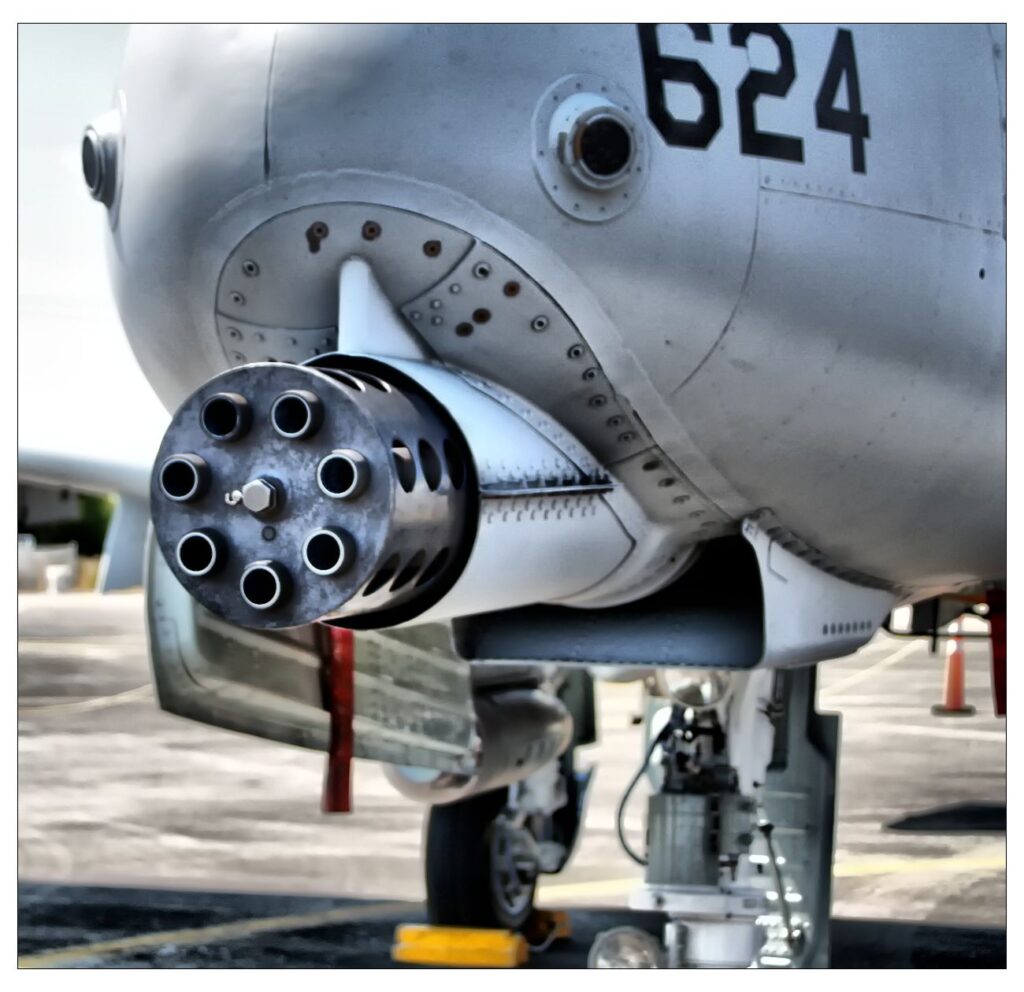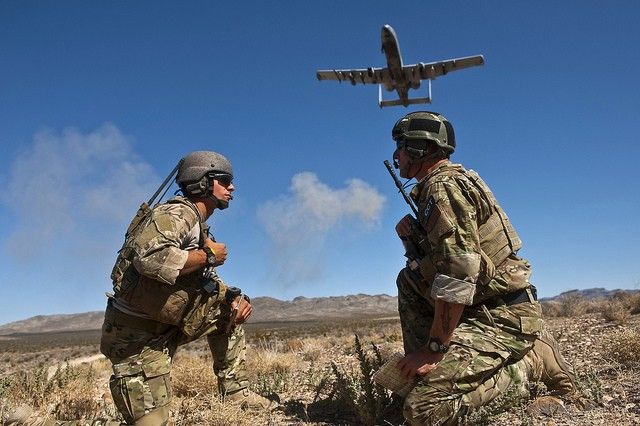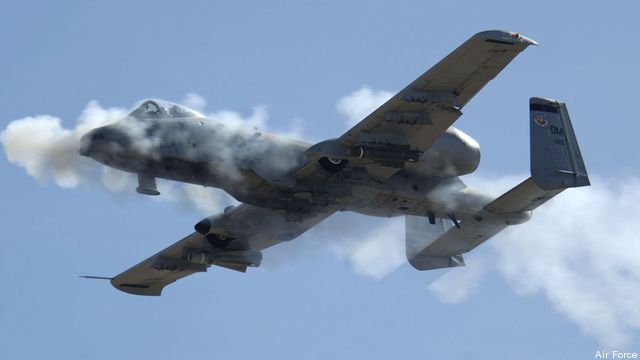WASHINGTON: The A-10 Warthog is ugly, tough, lethal, and fairly flexible. Its famous 30mm gun can destroy tanks or other armored vehicles with remarkable efficiency, not to mention enemy troops. Its titanium tub of a cockpit protects the plane’s pilot from most ground fire. Its pilots are trained to fly low and slow and to kill the enemy even when he is within yards of US forces. The Army and Marines love the Warthog.
In short, the A-10 appears to be the exemplar of Close Air Support, protecting Marines and Army troops when they face being overwhelmed by the enemy. Some members of Congress, with an eye on bases in their states and districts, love the plane as well and have championed legislation blocking the plane’s retirement.
Why, then, people ask, is the Air Force seriously considering sending the Warthogs to the great boneyard and their pilots to other missions? The answer is complex, but it boils down to three things: money, smart bombs, and threats.
First and foremost, retiring the entire A-10 fleet would save the Air Force $3.7 billion from 2015 to 2019. Retiring just some or even most of the A-10s wouldn’t reap nearly the same savings, because there are fixed costs in training and maintenance you can’t get rid off as long as you keep any planes.
Second, thanks to the wonder of smart bombs, most of the A-10’s mission can be done by other, less specialized aircraft. That wasn’t technologically possible when the A-10 first entered service in 1975. But in Afghanistan and Iraq, precision-guided munitions from faster-flying fighters and even heavy bombers have actually provided the overwhelming majority — 80 percent — of close air support.
Third, we’re not the only people with smart weapons. The Taliban and the Iraqi insurgents had at most a handful of shoulder-fired anti-aircraft missiles — known in the trade as Man-portable Air Defense Systems, or MANPADS — but an unknown number of MANPADS were smuggled out of Libya after Qaddafi fell, and the missiles on the black market are getting more sophisticated all the time.
That’s why the Air Force has planned for at least the last 15 years to replace the A-10s with the F-35A, its version of the JSF, which will reach initial operational capability (IOC) by the end of 2016. The F-35A will not only carry smart bombs but also have new, sophisticated sensors to guide them to ground targets — and it will fly much faster and higher than the A-10 can, making it a much harder target. While the JSF can’t carry the Warthog’s massive 30 mm gun, it does have a highly accurate 25 mm gun and 182 rounds of ammunition. (I asked Gen. Robin Rand, head of the Air Force’s Air Education and Training Command, last Friday if the F-35 carried enough ammunition to do the CAS mission. He said yes.)
 The B and C F-35 models can be fitted with a gun pod that carries 220 rounds but the pod disrupts the plane’s stealthy profile.
The B and C F-35 models can be fitted with a gun pod that carries 220 rounds but the pod disrupts the plane’s stealthy profile.
The Air Force has a long history of appearing to want to abandon the Close Air Support mission and stick with fighters and bombers, though there is no sign of that from the current Air Force leaders or their immediate predecessors. This unfortunate history means many observers still distrust the Air Force rationales for shutting down the A-10 fleet.
Air Force Chief of Staff Gen. Mark Welsh and his colleagues argue that in these days of declining budgets and the demands of enormous theaters such as the Pacific they must buy multi-role aircraft like the F-35 and the new Long Range Strike system. Single-mission aircraft, no matter how well suited they are to that mission, are just too expensive and limited.
 Those don’t seem unreasonable arguments, on their face. But the Air Force’s history of institutional indifference to the CAS mission combines with the broadly-held belief that no aircraft can do the CAS mission as well as the A-10 to spark opposition from ground pounders and Congress in particular.
Those don’t seem unreasonable arguments, on their face. But the Air Force’s history of institutional indifference to the CAS mission combines with the broadly-held belief that no aircraft can do the CAS mission as well as the A-10 to spark opposition from ground pounders and Congress in particular.
We spoke with the Army, the service with the most to lose should close air support diminish in effectiveness, and Air Force pilots who fly CAS missions to get both the official and off-the-record views. The official Army, in the form of Maj. Gen. Bill Hix, deputy director of the influential Training and Doctrine Command (TRADOC) Army Capabilities Integration Center, was surprisingly understanding of the Air Force’s idea to shutter the fleet. But Hix also offered a nuanced critique of the current CAS capabilities, in particular the A-10’s ability to fly low and slow and deliver firepower in bad weather.
“If the [A-10] aircraft and the specifically trained pilots go away, this mission will become a distant requirement hastily met with pilots who have been brought up on OCA [Offensive Counter-Air] and DCA (Defensive Counter-Air operations], and CAS that is provided will consist primarily of fast air-dropping JDAMs and other smart bombs on targets designated from the ground and then transitioning out of the area due to limited loiter time,” Hix said in an email.
He listed some very specific conditions where the A-10 and its ordnance are awfully useful:
- When “flying cover over outposts where attack helicopters can’t get (high altitude areas [e.g.] above 10,000 feet in the mountainous areas of Eastern Afghanistan for instance) and other USAF aircraft cannot get down/under the weather or fly in tight spaces (F-16, et al) or are too limited in numbers (AC-130).”
- When “there is little to no air-to-air/IADs [integrated air defense system] threat and its use eases the demand for artillery and ground logistics requirements to support that artillery (cannon or rocket)[:] think of the support provided by Warthog pilots during the march to Baghdad in 2003); and the 30mm [gun], which is unique and intimidating to those on the receiving end, but not as precise as the gun on the AH-64 or the AC-130.”
- He also made the crucial point, unaddressed by most in the Air Force, that the A-10 also serves as flying artillery, which is very useful in some situations. “CAS,” he writes, “is a complement to artillery and other indirect and air to surface fire support.”
Bottom line for the Army, per Hix: “That complementary mix of precision, area fires, sustained coverage, persistence, responsiveness and moral and physical effect remain important to success in ground combat; the A-10 carries a heavy complement of ordnance, while many other alternatives, like armed UAS, are more limited in their payloads; the A-10 is a good capability to have in the mix and even in limited numbers can continue to provide very useful and hard to replicate support on to ground troops.”
Note that reference to “limited numbers.” That seems to indicate the Army would accept retirement of much of the fleet but really wants the Air Force to keep some A-10s. But the Air Force makes the simple point that its big savings of $3.7 billion come only when it retires the entire fleet and gets rid of fixed overhead costs. As any student of aircraft acquisition knows, buying the planes is pretty cheap. More than three-quarters of a airborne weapon system’s costs typically come from parts, operations and maintenance.
The background view from a senior Army official was surprisingly accepting of the Air Force’s dilemma: “Tough times for all services and we have to leave it up to our counterparts to identify the best way forward to meet the CAS demands from the ground.”
Requests for air support, of course, aren’t the only thing coming from the ground. There’s also anti-aircraft fire — everything from MANPADS to sophisticated air defense missiles.
“I didn’t see the missile coming[;] my flight leader didn’t see the missile coming; my first indication of a missile launch was when it impacted my aircraft,” recalled Lt. Col. Kim Campbell, whose A-10 was hit over Baghdad in 2003. Fragments shredded much of the aircraft and cut its hydraulic control lines. But the plane’s famous titanium bathtub around the pilot kept Campbell alive, and amazingly, she managed to fly the wounded plane back to base.
Campbell argues the latest model, the A-10C, has better sensors and self-defense systems. “The A-10 has improved significantly,” she told Breaking Defense. “We’re better able to operate in these threat environments.”
But while the A-10 has been upgraded to handle some anti-aircraft threats, they still fly low and slow right into the enemy’s defenses. And in the air combat game, speed and advanced electronics are life.
To get a multi-role fighter pilot’s perspective, I spoke with an Air Force F-15E pilot (now a B-2 pilot), Capt. Michal Polidor, who was awarded the Distinguished Flying Cross for a 2009 close air support mission in Afghanistan. The F-15E was not designed for CAS but neither was the B-1 bomber, which along with the F-18 and other multirole aircraft, have provided more than three quarters of close air support since the terror attacks of 2001. Laser-guided and GPS-guided bombs and rockets have made this possible, along with intensive CAS training for multi-role pilots and greatly improved coordination with ground forces through Joint Terminal Attack Controllers (JTACs).
 Polidor was called by a JTAC to support 80 troops in danger of being overrun by massed Taliban forces eager to destroy Outpost Keating, a badly positioned base in Afghanistan that the enemy threw an estimated 300 fighters at in hopes of destroying it. He strafed a switchback road and dropped a mix of four bombs. Polidor was part of a fleet of 19 aircraft, including Army helicopters, that helped the men on the ground kill half the enemy force.
Polidor was called by a JTAC to support 80 troops in danger of being overrun by massed Taliban forces eager to destroy Outpost Keating, a badly positioned base in Afghanistan that the enemy threw an estimated 300 fighters at in hopes of destroying it. He strafed a switchback road and dropped a mix of four bombs. Polidor was part of a fleet of 19 aircraft, including Army helicopters, that helped the men on the ground kill half the enemy force.
Since the Strike Eagle, as the F-15E is known, usually concentrates on OCA and DCA, Polidor said he received six months of CAS training before he deployed to Afghanistan, where he was based at Bagram Air Base. That training was crucial because, in addition to strafing and bombing, PoIlidor had to set his plane up as a communications relay between the JTAC and the other aircraft. His backseater became a JTAC for 19 aircraft. According to his citation for the DFC, Polidor (on his first day of combat), “took control of the 19 aircraft on scene and orchestrated air strikes from six F-15Es, four A-10s, two AH-64s and a B-1.”
He would not offer an opinion as to whether the A-10 should be retired or not (he is a captain, after all) but he did note that other Air Force fighters simply have to fly much faster to be safe and maintain maneuverability than does the A-10. While that means the F-15 can get to the scene more quickly, it also means it must leave more quickly and cannot fly as low and slow as can the A-10. He said an A-10 could probably execute two strafing runs for each one he can do because of that slower speed and lower altitude.
The circumstances of Polidor’s operation offer a window into just why the Air Force thinks it may be able to replace the A-10 even before the F-35A is available in late 2016. (The Marine Corps F-35B will be available earlier, in late 2015, and the Navy F-35C model by February 2019).
His aircraft executed a complex strafing run of a twisting valley road and dropped two laser-guided bombs and two GPS-guided bombs and did not injure any US or allied solders. The aircraft he and his weapons officer directed killed 72 Taliban, almost half the enemy deaths, a fine demonstration of what Gen. Hix meant when he cited the value of Close Air Support as airborne artillery. The fact that Polidor was able to execute such an array of complex maneuvers on his first day of air combat is testament to the CAS training he received.
So what does all this say about the A-10? Certainly, many of its effects can be duplicated by other, newer aircraft and usually are. Its psychological or morale effect on ground troops — fear for the enemy and jubilation for Americans and our allies — cannot readily be duplicated since the other aircraft do not fly low and slow. The A-10 is more vulnerable to sophisticated anti-aircraft defenses than the other multi-role aircraft (although recent upgrades have improved the odds) and Air Force officials believe it will be too vulnerable within 10 years.
Richard Aboulafia, one of the deans of aerospace analysts at the Teal Group, aptly summed up the A-10s prospects:
“It has faced dangerous moments before, it has faced retirement before, and it’s pulled through. You can make an argument for it either way, it’s not a dumb plane to have around by any means, it’s a very useful plane; the argument is in a time of austerity no service can afford single mission aircraft.”
The Air Force can probably retire the entire A-10 fleet in several years, but neither Congress nor the Army will be completely comfortable with that. But the $3.7 billion the Air Force estimates it could save will be very tempting to harvest, especially once we have largely withdrawn from Afghanistan and the F-35s reach IOC. Our bet: retirement starting in fiscal 2016. That leaves time to educate and mollify Congress and to demonstrate to the Army its soldiers won’t be left without effective protection.
Air Force picks Anduril, General Atomics for next round of CCA work
The two vendors emerged successful from an original pool of five and are expected to carry their drone designs through a prototyping phase that will build and test aircraft.




























